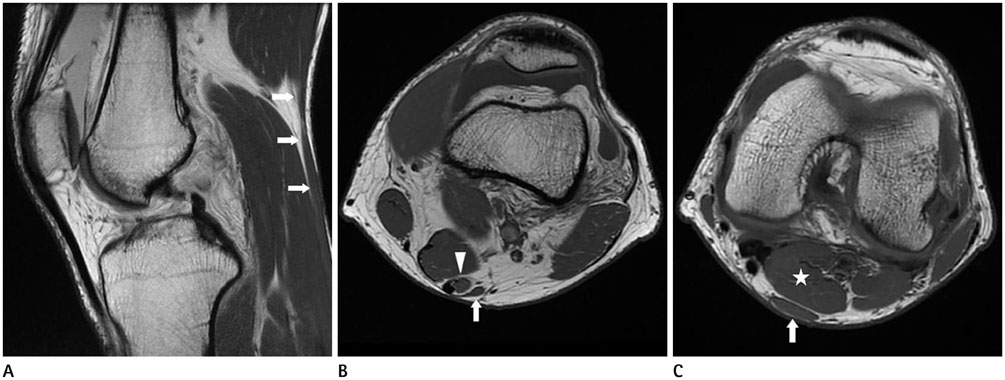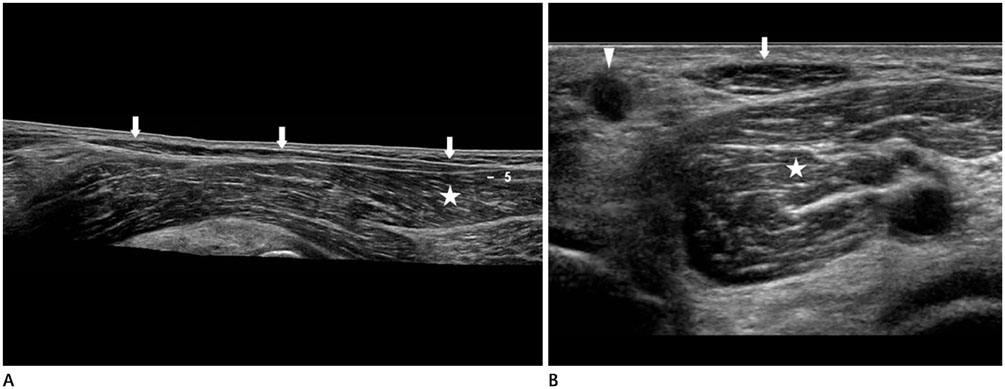J Korean Soc Radiol.
2015 Oct;73(4):249-251. 10.3348/jksr.2015.73.4.249.
MR Imaging and Ultrasonographic Findings of Tensor Fasciae Suralis Muscle: A Case Report
- Affiliations
-
- 1Department of Radiology, Seoul Paik Hospital, Inje University College of Medicine, Seoul, Korea. jcshim96@unitel.co.kr
- KMID: 2068715
- DOI: http://doi.org/10.3348/jksr.2015.73.4.249
Abstract
- The tensor fasciae suralis muscle is a very rare anomalous muscle located in the popliteal region. This anatomic variation has been reported often through cadaver studies. However, there are only a few radiologic reports of this entity. We presented a case of tensor fasciae suralis muscle detected as an incidental finding in magnetic resonance imaging and ultrasound.
MeSH Terms
Figure
Cited by 1 articles
-
Clinical importance of tensor fasciae suralis arising from linea aspera along with short head of biceps femoris: a rare anomaly
Bincy M. George, Satheesha B. Nayak, Sapna Marpalli
Anat Cell Biol. 2019;52(1):90-92. doi: 10.5115/acb.2019.52.1.90.
Reference
-
1. Luca C, Stan C, Popescu D, Mota O, Popescu P, Davalciuc O. The tensor fasciae suralis muscle - case report. Revista Romana de Anatomie Functionala si Clinica, Macro- si Microscopica si de Antropologie. 2009; 8:501–503.2. Chason DP, Schultz SM, Fleckenstein JL. Tensor fasciae suralis: depiction on MR images. AJR Am J Roentgenol. 1995; 165:1220–1221.3. Montet X, Sandoz A, Mauget D, Martinoli C, Bianchi S. Sonographic and MRI appearance of tensor fasciae suralis muscle, an uncommon cause of popliteal swelling. Skeletal Radiol. 2002; 31:536–538.4. Sookur PA, Naraghi AM, Bleakney RR, Jalan R, Chan O, White LM. Accessory muscles: anatomy, symptoms, and radiologic evaluation. Radiographics. 2008; 28:481–499.5. Dunn AW. Anomalous muscles simulating soft-tissue tumors in the lower extremities. Report of three cases. J Bone Joint Surg Am. 1965; 47:1397–1400.6. Tubbs RS, Salter EG, Oakes WJ. Dissection of a rare accessory muscle of the leg: the tensor fasciae suralis muscle. Clin Anat. 2006; 19:571–572.7. Stoane JM, Gordon DH. MRI of an accessory semimembranosus muscle. J Comput Assist Tomogr. 1995; 19:161–162.
- Full Text Links
- Actions
-
Cited
- CITED
-
- Close
- Share
- Similar articles
-
- Clinical importance of tensor fasciae suralis arising from linea aspera along with short head of biceps femoris: a rare anomaly
- Anatomical and Radiological Study of the Vascular Distribution and Skin Territory for the Tensor Fasciae Latae Free Flap
- Morphometric Characteristics of Arterial Supply of Tensor Fasciae Latae Muscle in Korean
- Ultrasound and MR Imaging Findings of Vulvar Leiomyoma: Case Report
- Brain Diffusion Tensor MR Imaging



